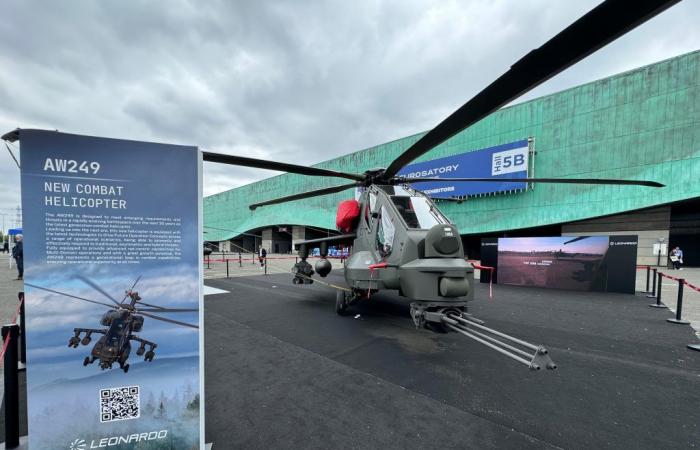
The loss of more than 90 attack helicopters that Russia already accumulates on the Ukrainian front has led various specialists to question the usefulness of this type of aircraft on the front. In this context, the United States canceled the program at the beginning of the year FARAwith which it had planned to acquire a new fleet of reconnaissance and attack helicopters, and Germany has chosen to retire its helicopter fleet earlier than planned Tigerwhile acquiring units of the more utilitarian model H145M. However, the Italian manufacturer Leonard has taken advantage of the lessons observed on the battlefield to apply them to your new model AW249which is presented for the first time this week at the international defense fair of Eurosatory, in France. “Due to an increasingly frequent combination of conventional, asymmetric and hybrid threats, the speed of technological evolution and changing scenarios require the integration of information in all domains (land, sea, sky, space and cyberspace).” This is how the manufacturer justifies the nature of its new helicopter, “intended for highly complex operations.” He Feniceas it has been baptized by the Italian Army, “stands out for its agile development process, which allows constant updating in the different production stages,” explains the source. At the moment there are two prototypes of the device that are already flying and two other units They are on the final assembly line.
The manufacturer designed the AW249 for multi-domain scenarios and future operational contexts, “in response to the growing need for multi-platform collaboration.” To create it, adds the information provided by the manufacturer, “an agile process has been followed, which allowed technological improvements and innovations to be made directly in the development phase, and is the result of a close synergy between the Italian Ministry of Defense and Leonardo”, which has included cooperation between the pilots of the current attack helicopters AW129 Mangusta of the Italian Army Aviation (BIRDS) and Leonardo’s test pilots. In this way, he says, “technical solutions based on real operational needs, such as hybrid and unconventional threats,” have been reached.
Tiger and Apache Competitor
He AW249which enters into direct competition with the European model Tiger and the American AH-64 Apache, is designed to operate in complex and congested scenarios. It is designed to move in information and communication environments that are increasingly interconnected and characterized by high threat profiles (kinetic, cybernetic and cognitive). These are the so-called peer or near-peer scenarios, in which the threat reaches comparable levels of organization and capabilities. These are strategic geographical areas that are difficult to access, known as bubbles. A2/AD (for anti-access/area denial).
AW249 attack helicopter on display for the first time at Eurosatory. Photo. Santi Moreno – Infodefensa.com
Compared to the AW129, the new helicopter, which will begin to be delivered to the Italian Army in 2027, surpasses it in range, speed, resistance in the operational area and maneuverability, and is easier to handle in all conditions. The aircraft, for example, “can hide behind an obstacle or a row of trees, then quickly perform evasive maneuvers and escape, taking advantage of the terrain configuration.” Or it can also “easily operate with greater awareness of environmental conditions, thanks to sensors and anti-collision systems, at high altitudes and in high temperature environments.”
Operate with zero visibility
Among many other improvements, the cabin of the new model is equipped with a color multifunction screen with a large touch surface to access functions and controls. It features a next-generation battlefield management system (BMS) that integrates data acquisition and processing to improve the command and control of a military unit. It can process and combine large amounts of data and transmit it to the crew in an intuitive and easy-to-use way through a modern cockpit equipped with THE D or through the display system integrated into the helmet (IHDS), which displays figures and information directly on the pilot’s case screen. It also projects images in a way that allows clear vision even in conditions of low light or degraded visibility, due to the presence of dust, sand, snow, rain or clouds, for example. To do this, a 3D reconstruction of the environment surrounding the aircraft is shown based on the data collected by all the sensors, which even allows it to operate, overcome any obstacle and land safely even with zero visibility.
An integrated drone
The pilot and co-pilot positions are identical and interchangeable, and it is possible to control an unmanned aerial vehicle from the cockpit (UAV) to manage its electrical and optical sensors with which to acquire images and videos of an area of interest. Integration with a drone allows you to expand the helicopter’s intelligence capabilities and optimize and improve the effectiveness of operations.
He AW249 It has a series of devices and sensors (technology lidarsensors GO and microwave radar) that provide “excellent situational awareness, essential for operating at low altitudes and evading threats.” Microwave radar even allows you to detect drones.
Artificial intelligence
It is also equipped with predictive systems capable of optimizing maintenance activities, with the aim of reducing downtime and the logistical impact of technical stops. The introduction of artificial intelligence allows for prescriptive maintenance by evaluating multiple options based on simulations. For example, for worn components, prescriptive maintenance allows calculating the different possible failures or maintaining the state of efficiency based on specific parameters and conditions.
The artificial intelligence it has also allows it to correlate and update parameters such as height, speed and the presence of obstacles in real time, ensuring that the helicopter can identify the safest routes to follow.





